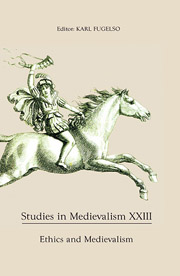Book contents
- Frontmatter
- Acknowledgments
- Contents
- List of Illustrations
- Epigraph
- Editorial Note
- I Ethics and Medievalism: Some Perspective(s)
- II Interpretations
- What if the Giants Returned to Albion for Vengeance? Crusade and the Mythic Other in the Knights of the Nine Expansion to The Elder Scrolls IV: Oblivion
- The Dark Ages of the Mind: Eugenics, Amnesia, and Historiography in Dan Brown's Inferno
- Plastic Pagans: Viking Human Sacrifice in Film and Television
- Meat Puzzles: Beowulf and Horror Film
- Words, Swords, and Truth: Competing Visions of Heroism in Beowulf on Screen
- Socialism and Translation: The Folks of William Morris's Beowulf
- “We Wol Sleen this False Traytor Deeth”: The Search for Immortality in Chaucer's Pardoner's Tale and J. K. Rowling's The Deathly Hallows
- Intention or Accident? Charles Alfred Stothard's Monumental Effigies of Great Britain
- Contributors
- Previously published volumes
Plastic Pagans: Viking Human Sacrifice in Film and Television
from II - Interpretations
Published online by Cambridge University Press: 05 May 2014
- Frontmatter
- Acknowledgments
- Contents
- List of Illustrations
- Epigraph
- Editorial Note
- I Ethics and Medievalism: Some Perspective(s)
- II Interpretations
- What if the Giants Returned to Albion for Vengeance? Crusade and the Mythic Other in the Knights of the Nine Expansion to The Elder Scrolls IV: Oblivion
- The Dark Ages of the Mind: Eugenics, Amnesia, and Historiography in Dan Brown's Inferno
- Plastic Pagans: Viking Human Sacrifice in Film and Television
- Meat Puzzles: Beowulf and Horror Film
- Words, Swords, and Truth: Competing Visions of Heroism in Beowulf on Screen
- Socialism and Translation: The Folks of William Morris's Beowulf
- “We Wol Sleen this False Traytor Deeth”: The Search for Immortality in Chaucer's Pardoner's Tale and J. K. Rowling's The Deathly Hallows
- Intention or Accident? Charles Alfred Stothard's Monumental Effigies of Great Britain
- Contributors
- Previously published volumes
Summary
Midvinterblot and the Problem of Ritual Killing
In 1915 the Swedish painter Carl Larsson completed a massive work commissioned by the National Museum of Sweden to crown its central staircase. Larsson proposed a work to complement his earlier depiction of King Gustav Vasa's triumphal entry in Stockholm, also hanging in the central staircase. The new painting, Midvinterblot, represented a scene from Norse legend: King Domaldi of Sweden offering himself in sacrifice at the temple of Uppsala to save his people from famine. Midvinterblot sparked controversy even before Larsson finished it. The art critic August Brunius called the painting “unreal” and “creepy,” comparing it to a “scene of cannibalism from darkest Africa.” It had no place in modern Sweden and no parallel in Gustav's heroic deliverance of the nation. The board of the museum agreed with Brunius and rejected the work as a depiction of a ritual killing. In 1984, the National Museum again refused to buy the painting, suggesting that it belonged instead in the Museum of National Antiquities with other relics of the pagan past. In 1997, following a popular exhibition of the painting, the National Museum finally acquired Midvinterblot and installed it above the staircase. After eighty-two years, Sweden made peace with King Domaldi.
Today we can appreciate Larsson's fascination with this legendary sacrifice, as well as the National Museum's long reluctance to accept it as a signal moment in Sweden's history.
- Type
- Chapter
- Information
- Studies in Medievalism XXIIIEthics and Medievalism, pp. 107 - 122Publisher: Boydell & BrewerPrint publication year: 2014



